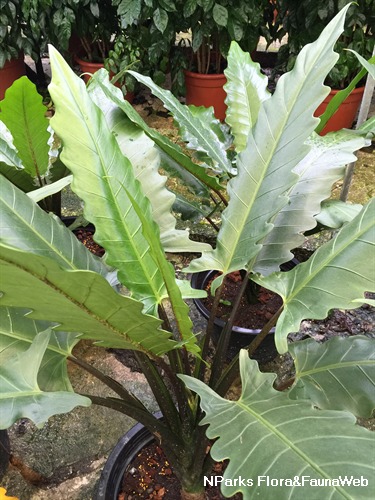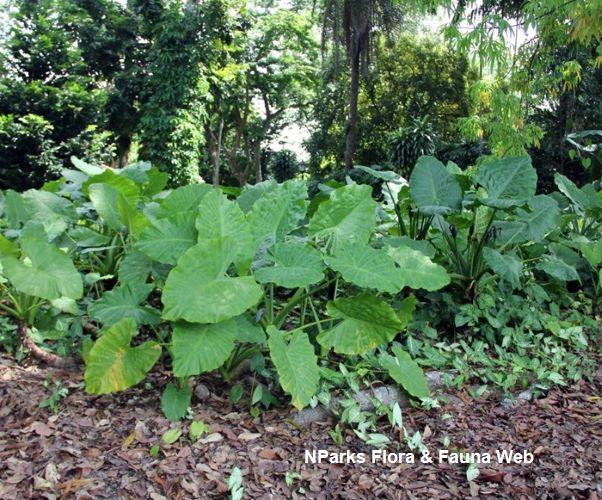.jpg)
Back
Alocasia cucullata (Lour.) G.Don
| Family Name: | Araceae |
| Common Name: | Chinese Taro, Hooded Dwarf Elephant Ear, 尖尾芋 |
Name
Classifications and Characteristics
| Plant Division | Angiosperms (Flowering Seed Plants) (Monocotyledon) |
|---|---|
| Plant Growth Form | Herbaceous Plant |
| Lifespan (in Singapore) | Perennial |
| Mode of Nutrition | Autotrophic |
| Plant Shape | Dwarf |
| Maximum Height | 1 m |
Biogeography
| Native Distribution | China |
|---|
Description and Ethnobotany
| Growth Form | A clumping evergreen herb, growing up to 1 m tall. |
|---|---|
| Foliage | Leaf blade broadly ovate to cordate, measuring 10 - 40 cm by 7 - 25 cm; base cordate; apex acute. |
| Stems | Upright growing stems, hypogeal. |
| Flowers | Inflorescence solitary although sometimes paired; peduncle 20 - 30 cm; spathe is green, measuring 9 - 15 cm; spadix is yellowish-white, measuring 8 - 15 cm. |
| Fruit | Berry, subglobose, red when ripens, measures 6 - 8 mm in diameter. |
| Cultivation | This species grows best in bright, but indirect light and in consistently moist, but well-drained soil. Apply slow release fertiliser monthly when the plant is actively growing. |
| Ethnobotanical Uses | Medicinal: Traditional Medicinal Uses The underground storage organ, known as a corm, is cooked and eaten to cure rheumatism and aches. However, the corm contains toxic calcium-oxalate crystals which must be broken down through cooking before consuming. It is important to note that some therapeutic effects from traditional medicinal uses of plants are not currently supported or verified by scientific research. Others: In Asian countries, this species is sometimes called ‘Buddha’s Hand’, because the large leaves are thought to resemble Buddha’s hands. Some people in Thailand and Laos grow this plant in front of their house, because they believe it brings good fortune. |
Landscaping Features
| Desirable Plant Features | Ornamental Foliage |
|---|---|
| Landscape Uses | Container Planting, Interiorscape/ Indoor Plant |
| Usage Hazard - Cons | Toxic Upon Ingestion |
Plant Care and Propagation
| Light Preference | Full Sun, Semi-Shade |
|---|---|
| Water Preference | Lots of Water, Occasional Misting |
| Plant Growth Rate | Fast |
| Rootzone Tolerance | Moist Soils, Well-Drained Soils, Fertile Loamy Soils |
Foliar
| Foliage Retention | Evergreen |
|---|---|
| Mature Foliage Colour(s) | Green |
| Mature Foliage Texture(s) | Glossy / Shiny, Bulging in between Veins, Thin |
| Prominent Young Flush Colour(s) | Green |
| Young Flush Texture(s) | Glossy / Shiny |
| Foliar Type | Simple / Unifoliate |
| Foliar Arrangement Along Stem | Basal |
| Foliar Attachment to Stem | Petiolate |
| Foliar Shape(s) | Non-Palm Foliage (Ovate, Cordate) |
| Foliar Venation | Palmate |
| Foliar Margin | Entire - Wavy / Undulate |
| Foliar Apex - Tip | Acute |
| Foliar Base | Cordate |
| Typical Foliar Area | Macrophyll ( 182.25cm2 - 1640.25 cm2 ) |
| Leaf Area Index (LAI) for Green Plot Ratio | 3.5 (Shrub & Groundcover - Monocot) |
| Typical Foliar Size | 10 cm to 40 cm |
Floral (Angiosperm)
| Flower & Plant Sexuality | Unisexual Flowers , Monoecious |
| Flower Colour(s) | White, Yellow / Golden |
|---|
| Flower Grouping | Cluster / Inflorescence |
| Flower Location | Terminal |
| Inflorescence Type | Spathe & Spadix |
Fruit, Seed and Spore
| Mature Fruit Colour(s) | Red |
|---|---|
| Mature Fruit Texture(s) | Smooth |
| Fruit Classification | Simple Fruit |
| Fruit Type |
Image Repository
Others
| Master ID | 336 |
|---|---|
| Species ID | 1632 |
| Flora Disclaimer | The information in this website has been compiled from reliable sources, such as reference works on medicinal plants. It is not a substitute for medical advice or treatment and NParks does not purport to provide any medical advice. Readers should always consult his/her physician before using or consuming a plant for medicinal purposes. |

.jpg)








